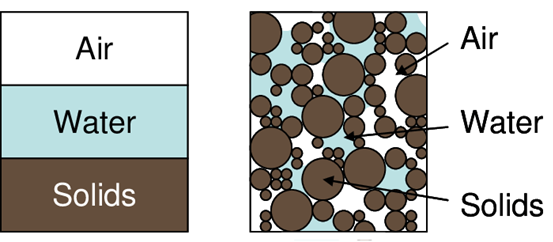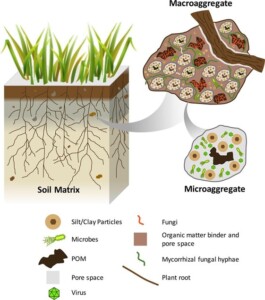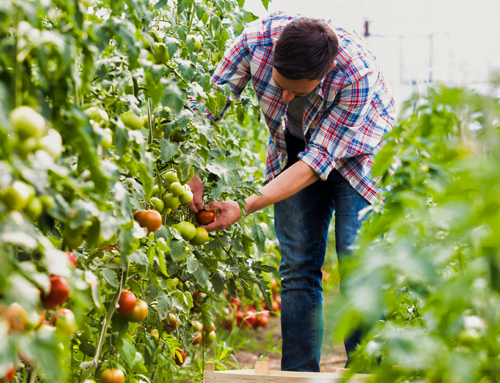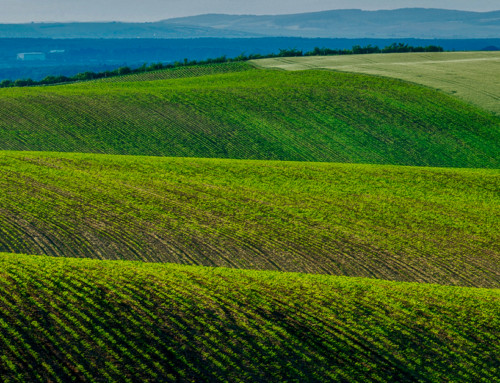Soil organisms play a series of fundamental roles in the interactions between soil and plants. Among several factors, soil water availability and drainage are directly governed by soil living organisms. They do that especially through organic matter processing and by changing soil structure.
Soil structure: Water and oxygen availability
Soil structure can be defined as the way in which soil particles are organized. Basically, soil is composed of three phases: Solid, liquid and gaseous. The solid phase is formed by mineral and organic particles, while liquid and gaseous phases correspond to water and air, respectively. Therefore, it is clear that the space occupied by the solid phase influences the air and water volume in soil.
Soil phase diagram (left) and generalized illustration of a soil cross-section (right). Source: Veenstra et al. (2005)
Soil porous phase has two main functions. Firstly, the micropores (pores with diameter < 0.05 mm) are responsible for the water holding capacity, thus they are fundamental to soil water availability. Soils with low volume of micropores – which is the case of most sandy soils – are more sensitive to drought once large amounts of rainfall water are easily leached, usually carrying nutrients and polluting groundwater. Secondly, macropores (diameter > 0.05 mm) drive soil drainage, then, are indispensable for oxygen availability and root respiration.
Organisms living within soil shape its structure through their activities, especially due to organic matter processing. As a result of this processing soil organisms degrade residual biomass from plants, converting it into humus. This decomposed organic matter acts as a binding agent for mineral particles and plays a crucial role in soil aggregation. Simplifying, organic matter works for mineral particles as cement for bricks. Hyphae from fungi also promotes soil aggregation by connecting and assembling mineral and organic particles.
Soil aggregation is important because macroporosity is usually low when mineral particles are poorly aggregated, therefore, undesirable consequences such as oxygen unavailability to plants and runoff as well as erosion are prone to occur. In contrast, when soil is organized in a more complex structure and the formation of macroaggregates is promoted, macropore volume is increased and suitable conditions for plant growth are established.
Scheme of soil organization in micro and macroaggregates. Source: Wilpiszeski et al. (2019).
Microaggregates (aggregate <250 μm) are organized in a simpler and smaller structure than macroaggregates (aggregate >250 μm). So, a macroaggregate is an association of many microaggregates due to electrostatic forces, cementing action of organic matter and/or fungi hyphae development. It is also possible to observe that this complex structure involves plant roots and exudates.
Plants can incorporate CO2 from the atmosphere into biomass through photosynthesis. They also release carbon-rich compounds into the soil as root exudates which stimulate the activity of soil organisms. After plant and soil organisms’ senescence, this organic carbon can be built up in soil if agricultural practices allow or favour it. This process shows how soil can work as a sink for carbon, mitigating global warming. Conversely, practices like soil disturbance by tillage promote organic carbon loss, making soil a source of CO2 to the atmosphere.
Additionally, after the death of plants and fungi, their residuals are decomposed, however, the space that plant roots and fungi hyphae have occupied for growing remains as voids, named as biopores. Biopores also can be formed by the activity and movement of macrofauna (i.e., earthworms and insects). This type of porosity contributes extensively more to soil drainage if compared to macroporosity formed by mechanized tillage. It occurs because biopores are interconnected through surface and deep soil layers while the pores occasioned by tillage are poorly linked.
Therefore, soil biodiversity is fundamental not only because the different organisms decompose fresh organic matter from plants, promoting soil aggregation, but also due to the formation of biopores. They contribute to a good balance between micropores and macropores, enhancing water holding capacity and drainage, respectively.
Strategies to protect soil biodiversity
Integrated management of pests, diseases and weeds – Using different approaches to manage pests, diseases and weeds is a pillar for sustainable agriculture. We have a broad range of options to deal with these issues.
There are many commercial products available in most countries for biological control of pests and diseases by using predators or parasitoids for selective control which prevents side effects on non-target individuals.
Using cover crops also is a practice able to decrease the incidence of weeds and has been largely used by farmers around the world for lowering the use of herbicides. Chemical control can be an alternative, but never the only one.
Fertilizers and amendments – Organic fertilizers and amendments usually favour the activity and abundance of soil organisms as they provide organic carbon and nutrients like nitrogen, which is essential for their metabolism.
In addition, avoiding the use of chloride-based fertilizers is important because this ion has a biocide effect. The main problem is related to the use of KCl which is the main fertilizer applied to supply K+, also carrying high Cl– contents. As a result, high Cl– rates are applied in soil, causing risk for soil biodiversity loss, mainly in production systems with high potassium demanding crops.
Below, there are some other articles that you might be interested in:
- Benefits of vermicompost and how it works
- Benefits of fungi for the environment and humans
- Soil biodiversity: contribution and threats
About the author

Pablo Ribeiro is a Chloride Free Ambassador, Brazilian, agronomist and PhD student at Kiel University, Germany, developing a project which aims to increase the use efficiency of nitrogen and water in agriculture.





Leave A Comment